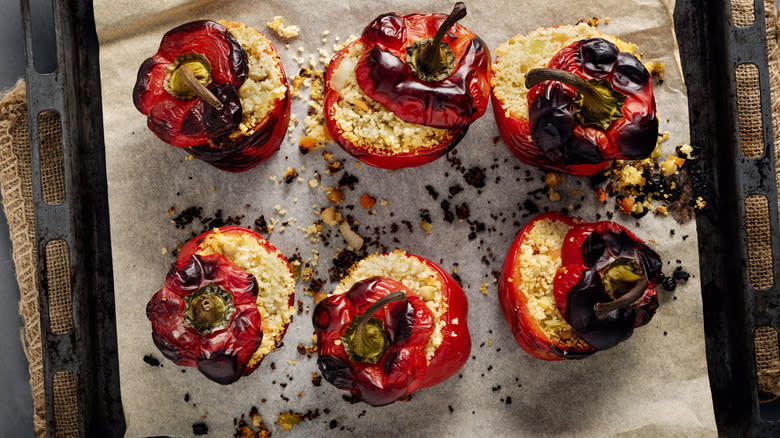Does It Really Matter If You Don't Cook The Rice Before Making Stuffed Peppers?

Stuffed peppers are a classic and versatile dish that can be made with various fillings, with rice being one of the most common ingredients. However, there is some debate about whether or not the rice should be cooked before it is added to the peppers, as rice traditionally requires pre-cooking before mixing with other ingredients. So, does it really matter if you don't cook the rice before making stuffed peppers?
Most recipes for stuffed peppers involve cooking the rice separately before incorporating it into the filling. This step ensures that the rice is fully cooked, tender, and ready to absorb the flavors of the other ingredients during the baking or simmering process. Pre-cooking the rice contributes to a well-balanced texture and consistency and ensures that the rice is fluffy rather than hard and undercooked. Also, with prepared rice, the overall cooking time for the stuffed peppers will be shorter. And yet, some home cooks skip the pre-cooking step as a time-saving measure, relying on the rice to cook inside the peppers during baking. This technique often allows the rice to absorb more flavors from the other ingredients and gives the stuffed peppers a slightly different texture.
Ultimately, deciding whether to cook the rice before making stuffed peppers is a personal preference. Pre-cook the rice if you want perfectly cooked rice, and don't mind an extra step in the cooking process. If you want to save time or enjoy a different texture, use uncooked rice instead.
Read more: 21 Delicious Ways To Use Up Leftover Rice
The Risks Of Uncooked Rice

While the convenience factor might be enticing, there are potential drawbacks to skipping the pre-cooking step for rice in stuffed peppers. Uncooked rice may absorb more moisture during baking, resulting in a crunchy or undercooked texture. Moreover, this technique might need more time to fully integrate with the flavors of the other ingredients, leading to a less harmonious taste in the final dish.
Fortunately, there are some alternative methods to strike a balance. One approach is to use parboiled or quick-cooking rice, which has undergone partial pre-cooking, reducing the risk of undercooked grains. Additionally, soaking the rice in water can help the grains absorb moisture and cook more evenly during baking.
Ultimately, home cooks are encouraged to experiment with both methods to find what suits their taste buds and fits their schedule. Some may appreciate the traditional way for its tried-and-true results, while others may embrace the convenience of a quicker approach. In cooking, traditions often collide with the need for efficiency. While pre-cooking rice has long been the standard, the growing popularity of skipping this step suggests that convenience is becoming increasingly popular.
Read the original article on Tasting Table.


